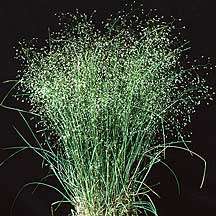Oryzopsis hymenoides
| Indian ricegrass | |
|---|---|
 | |
| Indian ricegrass growing in cryptobiotic crust at White Sands National Monument | |
| Scientific classification | |
| Kingdom: | Plantae |
| (unranked): | Angiosperms |
| (unranked): | Monocots |
| (unranked): | Commelinids |
| Order: | Poales |
| Family: | Poaceae |
| Genus: | Oryzopsis |
| Species: | O. hymenoides |
| Binomial name | |
| Oryzopsis hymenoides Ricker ex Piper[1] | |
| Synonyms[2] | |
|
Synonymy
| |
Oryzopsis hymenoides (Synonym: Stipa hymenoides, common names: Indian ricegrass and sand rice grass) is a perennial cool-season bunchgrass with very narrow, rolled leaf blades.[8] It is native to western North America east of the Cascades from British Columbia and Alberta south to southern California, northeastern Mexico, and Texas. In the wild, it typically grows 4 to 24 in (10 to 61 cm) tall and 8 to 12 in (20 to 30 cm) wide.[9]
O. hymenoides grows in a variety of habitats from desert scrub to ponderosa pine forests. It can live in soils from sand to clay, but it does particularly well in sand, where it is the dominant grass growing with sagebrush, and may occur almost unmixed with other plants.[9] It helps stabilize shifting sand.[10]:151
Cultivation

Indian ricegrass is an important food for livestock and for wild grazers such as bison, desert bighorn sheep, elk, mule deer, pronghorns, and jackrabbits. For some of these species, it is especially vital in late winter, as it produces green shoots earlier than other grasses. The seeds are heavily consumed by many rodents and birds, notably mourning doves.[9]
This tough grass is known for its ability to reseed and establish itself on sites damaged by fire or overgrazing. Much germination occurs in years with wet Aprils. It is grown in xeriscapes—cultivars are available—and will become quite large if given sufficient space. The open, spangled appearance when in flower or fruit is very attractive, especially in backlight. The flower stalk is commonly used in dry flower arrangements.[9]
Uses
In the past, the grass was a staple food of Native Americans, especially when the maize crop failed. Seed of the ricegrass was gathered and ground into meal or flour and made into bread. Since 2000, the ricegrass has been cultivated in Montana and marketed under the trade name Montina as a gluten-free grain.[11] The Zuni people used the ground seeds as a staple before the availability of corn.[12][13]
Symbol
It was officially recognized as the Nevada state grass in 1977[14][15] and as the Utah state grass in 1990.[16][17]
The Utah Section of the Society for Range Management began campaigning for a state grass in the mid-1980s, and after studying many species the field was narrowed to four candidates, Indian ricegrass, bluebunch wheatgrass, galleta grass, and Great Basin wildrye. Indian ricegrass was then selected. The state-grass bill was introduced by Senator Alarik Myrin, a member of the Society, in 1989.
References
- ↑ Contr. U.S. Natl. Herb. xi. 109 (1906) "Plant Name Details for Oryzopsis hymenoides". IPNI. Retrieved December 2, 2009.
Notes = Stipa hymenoides
- ↑ The Plant List, Oryzopsis hymenoides (Roem. & Schult.) Ricker ex Piper
- 1 2 3 "PLANTS Profile for Achnatherum hymenoides". USDA, NRCS. Retrieved December 2, 2009.
- ↑ Syst. Veg., ed. 15 bis [Roemer & Schultes] 2: 339. 1817 [Nov 1817] "Plant Name Details for Stipa hymenoides". IPNI. Retrieved December 2, 2009.
basionym of Poaceae Achnatherum hymenoides
- ↑ Gen.
N. Amer. Pl. [Nuttall]. 1: 40. 1818 [14 Jul 1818] "Plant Name Details for Eriocoma cuspidata". IPNI. Retrieved December 2, 2009.
Notes: =
Oryzopsis cuspidata - ↑ Dept. Agric. Special Rep. 63: 23. 1883 "Plant Name Details for Oryzopsis cuspidata". IPNI. Retrieved December 2, 2009.
nomenclatural synonym: Poaceae Eriocoma cuspidata Nutt.
- ↑ Phytologia 74(1): 7 (1993) "Plant Name Details for Achnatherum hymenoides". IPNI. Retrieved December 2, 2009.
Basionym: Stipa hymenoides
- ↑ Mojave Desert Wildflowers, Pam MacKay, 2nd Ed., p287
- 1 2 3 4 Tirmenstein, D. 1999. Achnatherum hymenoides. In: Fire Effects Information System, [Online]. U.S. Department of Agriculture, Forest Service, Rocky Mountain Research Station, Fire Sciences Laboratory (Producer). Retrieved on 2009-04-24.
- ↑ Canyon Country Wildflowers, Damian Fagan, 2nd ed., 2012, Morris Bush Publishing, LLC. in cooperation with Canyonlands Natural History Association, ISBN 978-0-7627-7013-7
- ↑ "The Montina Story". Amazing Grains. Retrieved March 30, 2010.
- ↑ Stevenson, Matilda Coxe 1915 Ethnobotany of the Zuni Indians. SI-BAE Annual Report #30 (p.67)
- ↑ Castetter, Edward F. 1935 Ethnobiological Studies in the American Southwest I. Uncultivated Native Plants Used as Sources of Food. University of New Mexico Bulletin 4(1):1-44 (p. 27)
- ↑ Nevada Revised Statutes, Chapter 235 Section 055. Retrieved on 2008-03-27
- ↑ Nevada Facts - State grass. Retrieved on 2008-03-27.
- ↑ Utah Code Section 63-13-5.5. State symbols. Retrieved on 2008-03-27.
- ↑ Utah State Symbols - Indian Ricegrass Pioneer - Utah's Online Library. Retrieved on 2010-06-29